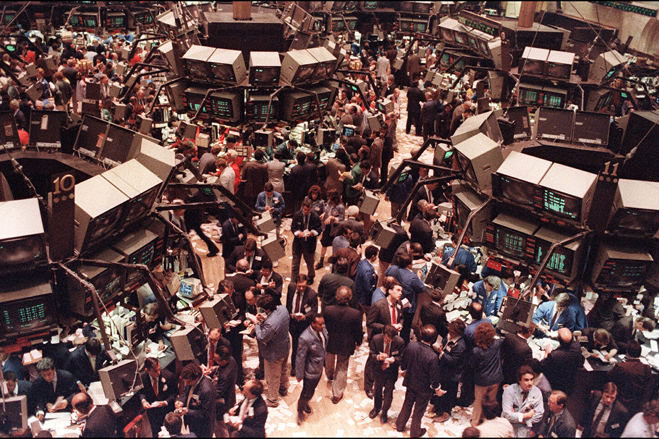Market Stabilization has Yet to be Achieved

Please note that we are not authorised to provide any investment advice. The content on this page is for information purposes only.
The US equity market was unable to sustain early gains yesterday and, although several Asian markets posted minor gains, Europe is seeing red again today. US equities are called lower as well. The European bond market rally continues, except for Greece, where the 10-year yield rose to about 70 bp over the past five sessions.
The US equity market was unable to sustain early gains yesterday and, although several Asian markets posted minor gains, Europe is seeing red again today. US equities are called lower as well. The European bond market rally continues, except for Greece, where the 10-year yield rose to about 70 bp over the past five sessions.
The EU seems to be resisting an early Greek exit from its aid program. Its stance threatens to cut off one of the legs of Prime Minister Samaras’s political strategies to avoid going to the polls next year, in which Syriza could win.
Meanwhile, the continued decline in oil prices and the knock on effects on inflation expectations continues to weigh on sentiment. Breakevens (difference in yields between the inflation linked bonds and conventional bonds) continue to slide. In the US, the 5 and 10-year breakevens are about 1.51% and 1.92% respectfully. These are the lowest reading since October/November 2011. The US 10-year yield is hovering around 2.20%.
The hawkish bias of the dot-plot released at last month’s FOMC meeting has been completely unwound. The gap between what the market is pricing the Fed to do next year and what the FOMC dot-plot says has widened. The market has pushed the expectations further out. The December 2015 Fed funds futures contract now implies less a 50 bp effective Fed funds rate. Just like the tapering began several months after the market had initially expected it, so too with the rate hike, the next important step in normalizing monetary policy.
Previously, we highlighted how the Federal Reserve is organizationally different from the ECB. The Fed’s Board of Governors is where policy is set. Regional presidents can influence the course, but are a minority, especially given that the NY Fed is often more aligned with the Board. They are also different when it comes to the economic impact of a significant change in oil prices.
Recall that in 2008 as oil prices moved above $140 a barrel, the ECB hiked rates for fear of the inflationary impact. In the US, higher oil prices were considered deflationary, as a tax on consumption (and business activity more broadly). Similarly, now the fall in oil prices is being seen in Europe as exacerbating the disinflationary headwinds, and perhaps tipping into outright deflation. In the US, the drop in oil prices may dampen headline inflation, but it will act like tax break for a wide swathe of the economy.
Yesterday, Sweden and the UK reported softer than expected inflation data. Today it was China’s turn. Inflation slipped to a five-year low in September of 1.6%, down from 2% in August. This was largely because of food prices, which slipped to 2.3% from 3%. Non-food prices eased to 1.3% from 1.5%.
Separately, China reported that the deflation in producer prices continues. In fact, the deflation has intensified with a 1.8% year-over-year decline. The consensus looked for a 1.5% decline after a 1.2% drop in August. It is the largest contraction since April. This may reflect not only the drop in some commodity prices, but the excess capacity and output despite slumping prices. It may be similar but different from the oil producers stepping up output into a falling market. High fixed costs, narrow margins, and a competitive environment generates a perverse logic.
The UK reported favorable employment data and a tick up in earnings growth. The ILO unemployment rate eased to 6.0% in September from 6.2%. The claimant count fell by almost 19k, which was about half of the decline the consensus expected. August average weekly earnings (3-month) edged higher to 0.7% from 0.6%, and excluding bonuses, rose 0.9% after a revised 0.8% in July (initially 0.7%). Nominal earnings growth continues to lag behind even the lower inflation.
The OIS curve implies the market has pushed out expectations for the first rate hike to the end of Q3 15 or early Q4. One of the dissenting hawks on the MPC, Weale, is speaking after the London markets close today. His take on softer inflation, weak earnings growth, and an economy that appears to have recorded its cyclical peak a few months ago will interest investors. However, it is clear he does not speak for the majority.
After a slow start to the week, the US economic calendar fills up today. Retail sales may be the most important, but the headline is likely to be weighed down by the softer auto sales and the drop in gasoline prices. The GDP component, which excludes these two items and building materials, is expected to continue to rise (0.4% same as in August). Of note, US consumption is not being driven by revolving credit (credit cards), where growth remains weak.
The US also reports producer prices and August business inventories. The former will be overshadowed by the retail sales, while the latter will help economists’ fine tune Q3 GDP estimates.
We suspect the US economy lost some momentum in late-Q3, which is likely to carry over into Q4. The Empire survey is expected to reflect this. The Beige Book may attract interest, especially if some strong parts of the economy show signs of cooling, like the energy sector. Will it be sufficient to forestall the Dallas Fed President from dissenting again at the FOMC meeting later this month?
Markets Still Struggling to Stabilize is republished with permission from Marc to Market




